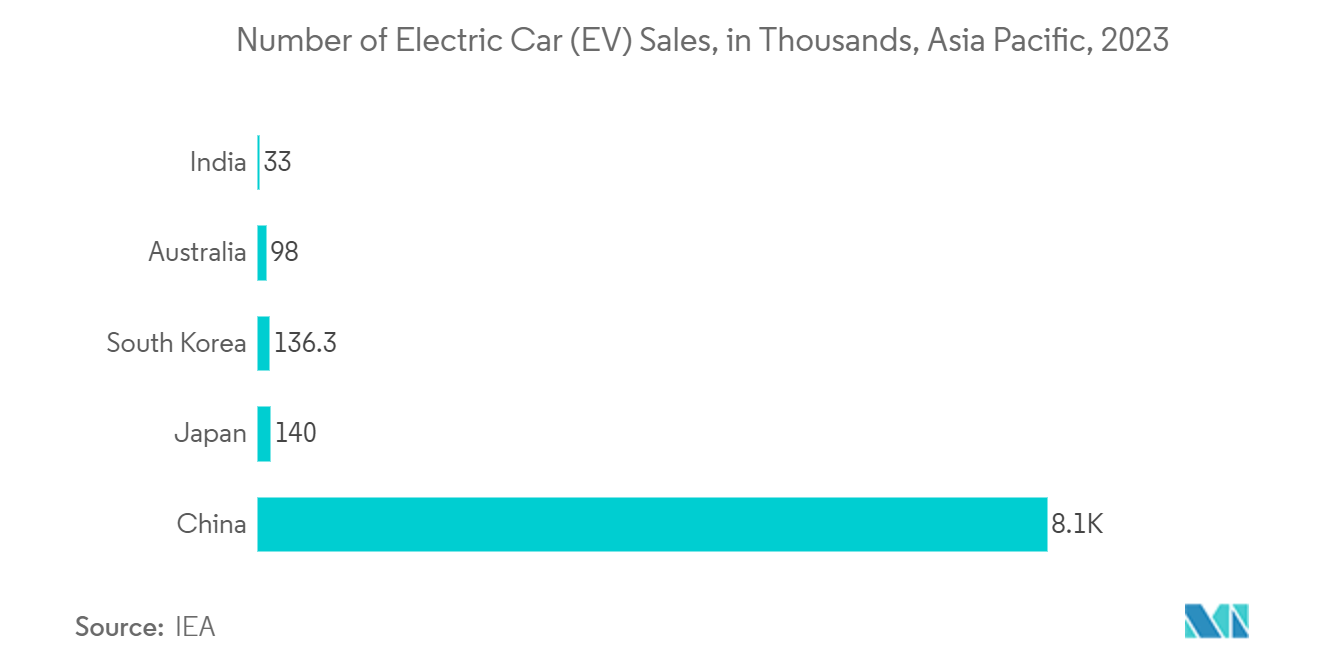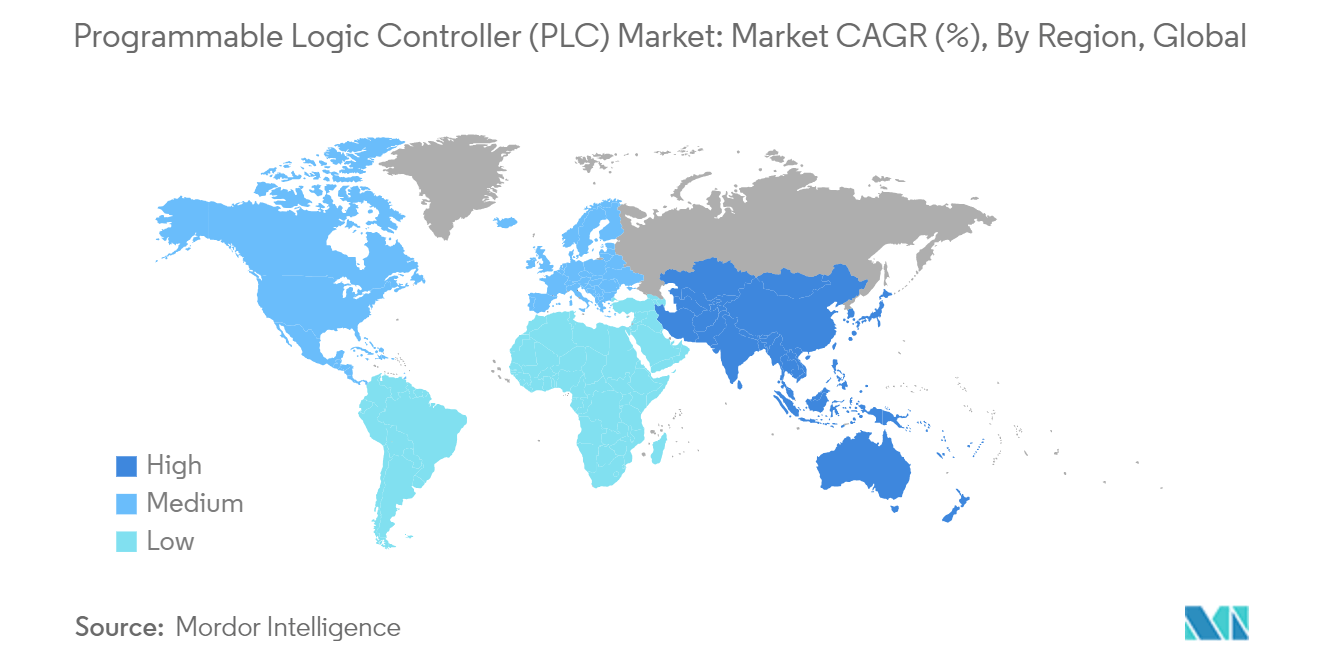Market Trends of Programmable Logic Controller (PLC) Industry
Automotive Industry to be the Fastest Growing End User
- PLCs can be used in various automotive manufacturing applications, including assembly lines, painting, and welding. They control the movement of materials and parts on the production line, ensuring efficient operations, which shows the potential demand for PLC systems in line with the growth of Automotive manufacturing worldwide. The potential for PLC in automotive manufacturing expands as technology evolves. Integrating Artificial Intelligence (AI) and the Internet of Things (IoT) with PLC paves the way for smart factories. These factories can monitor and optimize production in real-time, heightening efficiency. For instance, machines equipped with sensors can gather performance data and make necessary adjustments to enhance production.
- The automobile industry finds many PLC applications from the product application view, and the most significant amount is medium-sized PLC. Some forms of the PLC are mostly at the electric car's former disposal in the application. Moreover, the PLC market in the automotive industry is anticipated to expand further with new technologies such as machine vision, collaborative robotics, artificial intelligence for driverless/autonomous automobiles, cognitive computing in IoT-connected cars, and more. Furthermore, many automakers are expanding their Electric Vehicle factory in the studied region, further driving the market, which would support the demand for smart factories and create a growth opportunity for the market vendors.
- For instance, in October 2023, Hyundai planned to build its first US electric vehicle plant, with production on track for 2025. This would support the expansion of automobile manufacturing in the market and create a demand for PLC systems due to their applications in plant automation.
- Manufacturers managing multiple automation control points increasingly opt for centralized management to boost visibility and security. This trend would drive the demand for advanced PLC solutions in the market.
- For example, in May 2024, Ford Motors announced its plan to implement an automated system from Siemens to centralize its factory control. This innovative solution merges the capabilities of a hardware Programmable Logic Controller (PLC), a traditional Human Machine Interface, and an edge device into a unified, software-driven platform. By integrating Internet Technology (IT) workflows into Operational Technology (OT) environments, the system streamlines operations and underscores the technological strides in PLC solutions, bolstering their market adoption rate.
- Significant Growth in Electric Vehicles (EVs) To Boost the Market Demand. PLCs are essential for controlling the various robotic systems, conveyors, and machines that perform welding, painting, material handling, and assembly in EV production facilities. According to IEA, in 2023, China experienced the most electric car sales throughout the Asia-Pacific region, with over eight million electric cars sold.
- Therefore, deploying PLCs in automotive manufacturing results in benefits such as enhancing productivity and quality while minimizing downtime. Manufacturers can boost production rates through process automation while decreasing error probabilities, supporting the growth of the studied market in the future.

Asia-Pacific to Register Major Growth
- China's push for industrial automation, especially in manufacturing, automotive, electronics, and chemicals, is crucial for adopting PLC. The Chinese government has launched initiatives, such as Made in China 2025, to modernize its manufacturing sector through automation and smart technologies. This has increased investments in PLC systems to improve efficiency, reduce human error, and enhance production line flexibility. In 2023, the sales volume of automated mobile robots (AMR) and automated guided vehicles (AGV) amounted to 140 thousand units.
- China recently released multiple industrial policies as part of its advanced manufacturing drive. The guidelines support the country's objective of becoming a high-tech superpower during the next quarter-century. For instance, the Chinese government has been pushing for the industrial use of next-generation wireless technology amid a steady stream of directives focused on transforming the country's manufacturing.
- According to the International Federation of Robotics (IFR), China's massive investment in industrial robotics has put the nation in the top ranking in terms of robot density, surpassing the United States for the first time. The ratio of operational industrial robots to workers in manufacturing reached 322 units per 10,000 employees. The nation leads in annual robot installations and has consistently boasted the most significant operational stock of robots for several years.
- The fastest-growing vertical markets in the country are expected to facilitate robotics applications across different verticals, as China now accounts for almost a quarter of all the industrial robots installed globally (IFR). Also, the Wuhan University Institute of Quality Development Strategy predicts that by 2025, machinery and robotics will replace nearly 5% of China’s workforce. Such investments are expected to drive the PLC market during the forecast period.
- India's manufacturing sector, driven by initiatives like "Make in India,” is increasingly adopting automation to enhance productivity, quality, and competitiveness. Industries such as automotive, electronics, textiles, and food and beverages are investing in PLC-based automation systems to streamline operations and reduce human intervention, which leads to increased demand for PLCs.
- According to IBEF, India's electric vehicle (EV) market is estimated to reach USD 7.09 billion (INR 50,000 crore) by 2025. A study by the CEEW Centre for Energy Finance recognized a USD 206 billion opportunity for electric vehicles in India by 2030. This will necessitate a USD 180 billion investment in vehicle manufacturing and charging infrastructure.
- Japan is a significant player in industrial automation, with industries like automotive, electronics, and manufacturing increasingly adopting smart factory solutions. PLCs are crucial in automating production processes, improving efficiency, and reducing operational costs. The push toward "Industry 4.0" and "Society 5.0" initiatives encourages greater adoption of PLCs to enable smart manufacturing systems.


